
(Part 1)
Contents
![]() The Gallery
The Gallery
![]() Productions
Productions
![]() 1960s Part 1
1960s Part 1
|
Contents
|
| Trial by Jury | March 1960 |
| Murder in the Cathedral | Dec 1960 |
| Patience | Dec 1961 |
| Much Ado About Nothing | Dec 1962 |
| VIth Form Revue | Summer 1963 |
|
|
Select a page and use your Browser's 'BACK' button to return here: |
| The Programme ... | ... select a page |
Murder in the Cathedral
(December 1960)
The Murder
Select a page and use your Browser's 'BACK' button to return here:
The Programme ....
.... select a page
Keith ('Bob') Beardsley in the lead role
(No enlargement available)A review of the play was published in The Journal on Friday 16th December 1960. The original article has been divided into segments and scanned. Due to the age of the paper and the poor print technology of 40 years ago, quality is not 'of the best!'
Click these thumbnail images to see enlarged versions and use your Browser's 'BACK' button to return here.
|
|
Select a page and use your Browser's 'BACK' button to return here: |
| The Programme ... | ... select a page |
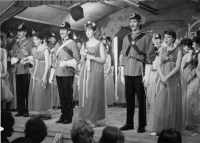 |
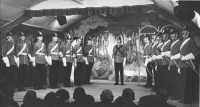 |
 |
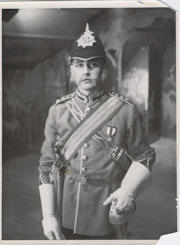 |
| Photo 1 | Photo 2 | Photo 3 | Keith Swetman as Colonel Calverley |
THOUGHTS AFTER PATIENCE
by Roger GarrardIt is always a sad moment when the last audience files slowly out of Tomlinson Hall on a Sunday afternoon. The lingering mums and dads greet their actor sons or daughters, now with peeling moustaches and fading make-up. In a bizarre mixture of sweaters, plimsolls and some actor's forgotten hat, the stage-hands wander desultorily among the abandoned props and flapping scenery that took so long to make ready. The floodlights crackle, their metal frames contracting with relief. A stale heat, as of a humid hothouse, still rises from the switchboard area, so lately the centre of feverish activity. Tomorrow, a few hours will be sufficient to take down the lights, put away the scenery, despatch the hired costumes, wash the home-made ones, and remove the extra seats. The hall will soon be cold and empty again.
This particular Sunday seemed rather more of an anti-climax than usual. It was just possible that this was the last major production in Tomlinson. Every year, since "She Stoops to Conquer" was performed in 1953, has seen an attempt to make a theatre out of a nissen hut. Each play has created new problems; each time, somehow, they have been overcome or circumvented.
Perhaps the biggest headache of all was that flying saucer. I wonder how many still here can remember "Down to Earth," Mr. Wrench's second operetta, and how many knew what a complexity of manoeuvres was needed to change the scenes. We had only a segment of a saucer, if that is the right word, which, even so, was so big we could not keep it back-stage, but had to have a special shed built behind the hall, and four sturdy lads to carry it from there and back twice during each performance, without knocking over any of the 60 in the cast, who at one point had all to share the stage with the monster.
Then there was the real tree for the woodland setting of "A Midsummer Night's Dream," a handsome gift from Miss King. It was felled, lopped, transported here, and re-erected on the stage by another four sturdy lads. You can still see the patch on the plasterboard where the top of the trunk wedged into the curved wall of the hut.
Ah, those curved walls! What mockery they have made of conventional stage movements, and yet how convenient, as in this case. You can nail into them, if you know where, paint them, use them, hide them, even ignore them, but they are there in every production. Perhaps their greatest hour may be yet to come, if we were to do Lionel Bart's "Blitz," or some other piece set in a London tube station, for here would be absolute realism of setting.
Yes, despite all the cursing over the years, it will be with a touch of regret that we move our dramatic activities into a more suitable building in years to come. But it will not be just yet, after all, so next term may well witness another episode in the life of Tomlinson Hall theatre. And whatever the scenery may look like, however colourful the lighting effects, one may well say "Plus ša change ..."
R. J. G.
Much Ado About Nothing
(December 1962)
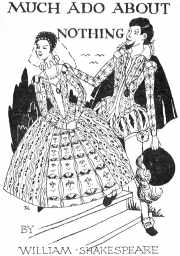
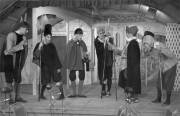 |
||
|
The Programme |
The Press review |
The photographs (72 of them) |
From the 1963 College Magazine:
Last December, in accordance with the policy of a yearly alternation of a play and a musical production, the senior school staged Shakespeare's " Much Ado About Nothing". This comedy, written during the middle period of the playwright's career, appeals to some because of its sophisticated and witty pair of lovers, Beatrice and Benedick, and to others because of the rich burlesque of the Elizabethan police force through the persons of Dogberry, Verges and the Watch.
There is an ironical situation in that Beatrice and Benedick are jockeyed into realising their mutual love by the skilful manipulation of the circumstances set in motion by Don John, the " cardboard " villain, and by Don Pedro's contrivances. In contrast are Claudio and Hero, the more placid pair of lovers. In the sub-plot we see the humble and yet pompous constables with the loquacious Dogberry, who has much ado continuously misusing the English language and punishing the right people for the wrong reasons.
The success of the play greatly depends on the playing of Beatrice and Benedick, and these parts Lesley Sayles and Anthony Dyson performed admirably. John Wood's interpretation of Don Pedro was notable for its finely-spoken verse, and Jane Ford and Paul Townsend as Hero and Claudio also deserve mention, the former as an appealing innocent and the latter in a less attractive part. The constables, supposedly medieval Sicilians, were transformed into clodhopping Norfolk rustics with authentic Norfolk accents, and with Dogberry, played by Brian Perry, and Verges, played by Thomas Lawrence, they stole the limelight in all their scenes.
It is not difficult to realise how much a successful play production owes to the people behind the scenes, though they do not always receive a big enough share of the credit. Much of this must be allotted to Mr. Garrard, under whose critical, experienced, but appreciative eye the production took shape. The scenery, designed and painted by Miss Harmer and constructed by a team of boys, was simple yet effective, giving a realistic effect of Mediterranean sun and heat, remarkable on so small a stage. With the colourful costumes, designed by Miss Colls and made by the girls, and the effective make-up, it can undoubtedly be said that the play was a great success with our audiences.
Finally one must mention the contribution of the College orchestra to the entertainment. At Stratford nowadays a Shakespeare production is not complete without music composed specially for it. It is pleasant to reflect that this applies also to Wymondham College productions. Mr. Wrench, having composed Elizabethan incidental music for us, also directed and conducted the orchestra, and this can certainly be said to have given the final polish to this year's performances of " Much Ado."
EDGAR RICHES.
The Revue now has its own page.
Wymondham College Remembered - Rolls neater, smokes sweeter